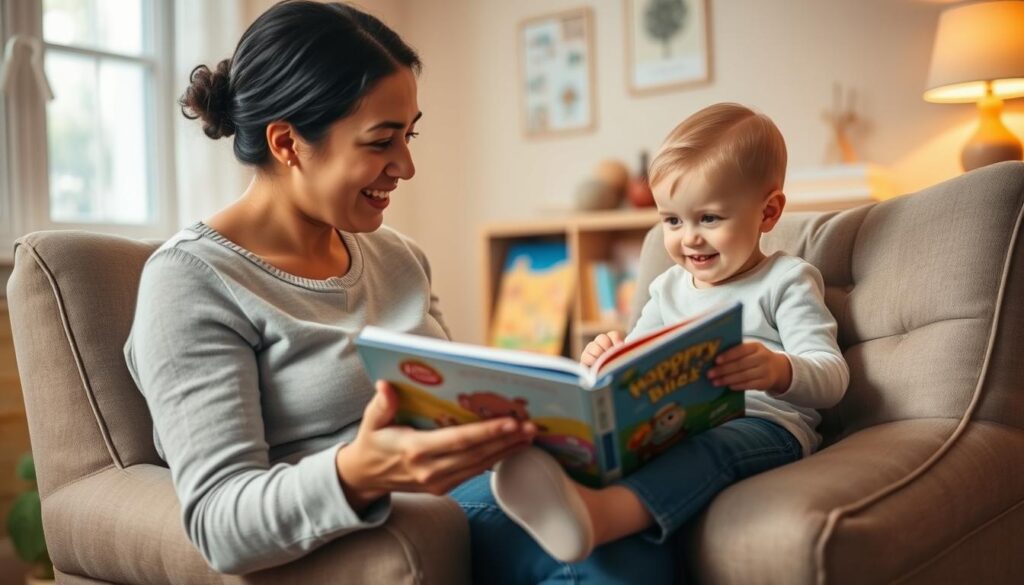Are you wondering how to make reading a magical experience for your little one? Reading aloud to your toddler is more than just sharing a story; it’s about creating a foundation for lifelong learning and literacy development.
As a parent, you have the power to foster a love for books and learning in your child. Regular reading sessions can significantly enhance their language acquisition and cognitive development. But, let’s be real, engaging active children can be challenging!
Don’t worry, with persistence and the right approach, you can turn potentially chaotic reading sessions into special moments of connection. In this article, we’ll explore practical tips to help you maximize your toddler’s engagement during reading time, enhancing their skills and vocabulary along the way.
The Power of Reading Aloud to Toddlers
Reading aloud to toddlers is a powerful tool that lays the foundation for their future academic success. It’s an activity that not only fosters a love for reading but also has a wide range of benefits that extend beyond literacy skills.
Building Language and Literacy Skills
When you read aloud to your toddler, you’re helping them develop essential language and literacy skills. This includes learning new vocabulary, understanding sentence structures, and developing an awareness of the sounds and rhythms of language. Research has shown that children who are read to regularly have larger vocabularies and better language comprehension than those who aren’t.
Fostering Emotional Connections
Reading aloud to toddlers is also a great way to foster emotional connections and create special bonding moments. As you read together, you’re not just sharing a story; you’re sharing an experience that can help strengthen your relationship and create lasting memories. This shared experience can help your child feel secure and loved, laying the groundwork for healthy emotional development.
Developing Attention and Listening Skills
The act of reading aloud to toddlers also helps them develop crucial attention and listening skills. As they listen to the story, they’re learning to focus their attention, understand the narrative, and make connections between the text and the world around them. Some key benefits include:
- Improved listening skills
- Better comprehension of complex ideas
- Enhanced ability to follow instructions
By reading aloud to your toddler, you’re giving them a gift that will last a lifetime – a love of reading, a strong foundation in language and literacy skills, and a deeper connection with you.
Creating the Perfect Reading Environment
The atmosphere in which we read to our toddlers significantly impacts their engagement and learning. A big part of sharing a book with babies and toddlers is the intimacy of reading together—the snuggles, the conversation, the joint attention directed to the book and each other.
Cozy Reading Nook
To create a dedicated reading space, start by choosing a quiet corner in your home with minimal distractions. Use items you already have, like comfy pillows and soft blankets, to make the space inviting. This will help your toddler feel comfortable and relaxed during reading time.

Optimal Reading Time
Choosing the right time of day for reading is crucial. Consider your toddler’s energy levels and attention span. Typically, after meals or before bedtime is a good time when their physical needs have been met, and they’re more likely to be calm and engaged.
Managing Distractions
To minimize distractions during reading, turn off the TV and put away electronic devices. Set realistic expectations for your toddler’s attention span, and gradually increase reading time as they grow. Incorporating reading into daily routines can help create consistency and make it a special part of your day together.
| Tips for a Perfect Reading Environment | Benefits |
|---|---|
| Create a cozy reading nook | Increases comfort and relaxation |
| Choose the right time of day | Improves engagement and attention |
| Minimize distractions | Enhances focus and learning |
Selecting Books That Captivate Toddlers
Selecting books that captivate toddlers is an art that requires consideration of several factors. The right books can engage young children and foster a lifelong love of reading. As you choose books for your toddler, it’s essential to consider their age, interests, and developmental stage.
Age-Appropriate Book Characteristics
For toddlers, books with bright illustrations, interactive elements, and relatable content are particularly appealing. Board books with simple, sturdy pages are perfect for younger toddlers, while older toddlers can enjoy more complex storylines and pictures. These books should be rich in content that connects to children‘s interests and prior experiences.
Diverse and Inclusive Book Options
It’s also crucial to choose books that feature diverse characters and settings. This helps children develop an understanding of the wider world and different perspectives. By exposing your toddler to books that reflect various cultures, experiences, and lifestyles, you’re helping them become more empathetic and open-minded towards others.
Balancing Familiar Favorites and New Discoveries
To keep the reading experience fresh and exciting, it’s a good idea to strike a balance between familiar favorites and new discoveries. Re-reading beloved books can provide comfort and a sense of security for children, while introducing new books can spark their curiosity and keep them engaged. This balance is key to maintaining a love for reading.
Essential Tips for Reading Aloud to Toddlers
Reading to your toddler is more than just sharing stories; it’s about creating an experience that fosters their development and love for reading. As you read aloud, you’re not just entertaining your child, you’re also enhancing their language skills, imagination, and attention span.
Using Different Voices and Expressions
One of the most effective ways to bring stories to life is by using different voices for characters. This technique helps toddlers distinguish between characters and narration, making the story more engaging. For instance, you can use a high-pitched voice for a mouse and a deep voice for a bear. Don’t be afraid to add expressions and emotions to your reading; it’s okay to be a bit dramatic! This will not only captivate your child’s attention but also help them understand the story better.
Incorporating Movement and Sound Effects
Incorporating movement and sound effects into your reading can make the experience more interactive and fun for your toddler. You can use gestures to act out the story, make animal sounds, or even move around the room to mimic the characters’ actions. This interactive approach not only keeps your child engaged but also encourages them to participate physically in the story, satisfying their need for activity.
Pacing and Pausing Effectively
Pacing is crucial when reading aloud to toddlers. You need to read slowly enough for comprehension but dynamically enough to maintain their attention. Pausing at strategic moments can build anticipation, allow for processing time, and create opportunities for your child to respond. For example, you can pause before revealing what’s behind a flap in a storybook, encouraging your child to guess what’s coming next.
| Technique | Benefit |
|---|---|
| Using different voices | Enhances character distinction and engagement |
| Incorporating movement and sound effects | Makes the story interactive and fun |
| Pacing and pausing | Improves comprehension and builds anticipation |
Making Reading Interactive and Engaging
As you read aloud, turning the experience into an interactive adventure can be a game-changer for your child’s learning. It’s not just about reading the words on the page; it’s about bringing the story to life and making your child an active participant.
Asking Open-Ended Questions
One effective way to encourage interactivity is by asking questions that prompt your child to think critically about the story. Instead of asking yes or no questions, use open-ended questions that begin with what, how, or why. For example, you might ask, “What’s happening in this picture?” or “How do you think the character is feeling?” This not only engages your child but also helps build their language skills by encouraging them to describe what’s happening in the picture.
Encouraging Predictions and Participation
Inviting your toddler to make predictions about what might happen next in the story is another great way to foster engagement. You can ask, “What do you think will happen if…?” or “Where do you think they’re going?” This encourages your child to participate actively in the storytelling process. You can also encourage participation by repeating phrases or actions within the story and inviting your child to join in.
Using Props and Visual Aids
Incorporating props, puppets, or other visual aids can extend the story experience beyond the pages of the book. For instance, if you’re reading a story about animals, you can use toy figures to represent the characters. This makes the story more tangible and engaging for your child. As you read aloud, feel free to ask questions about the props or characters, further enhancing the interactive experience.

By making these simple adjustments to your reading routine, you can significantly enhance your child’s engagement and comprehension. Remember, the goal is to make reading a dynamic and enjoyable experience that fosters a lifelong love of learning.
Building Vocabulary and Comprehension
When reading to toddlers, it’s crucial to implement techniques that foster both vocabulary growth and a deeper understanding of the text. This not only enhances their language skills but also lays the foundation for future literacy.
Explaining New Words in Context
One effective way to build vocabulary is by explaining new words within the context of the story. For instance, if you’re reading a book that mentions a “safari,” you can briefly explain what that means. You might say, “A safari is an adventure where people go to see animals in their natural habitats.” This helps your child understand the word’s meaning without interrupting the story’s flow.
To reinforce new vocabulary, try using these words in conversations outside of reading time. For example, you could say, “Remember our safari adventure in the book? Let’s go on a safari in our backyard and see the birds!” This makes the word a part of their active vocabulary.
Making Real-Life Connections
Helping toddlers connect what they read to their real-life experiences strengthens both comprehension and relevance. For example, if a story mentions baking cookies, you could relate it to a time when you baked cookies together. Ask questions like, “What was your favorite part about baking cookies?” This encourages your child to think critically about the story and its connections to their life.
Encouraging Visualization
Good readers often visualize the story as they read. Encourage this by asking your toddler to close their eyes and picture a scene or character. For example, you might say, “Can you imagine what the dragon looks like in this story? What color is it?” This builds mental imagery skills that support reading comprehension.
To check understanding and encourage participation, ask simple questions like, “What do you think will happen next?” or “How do you think the character is feeling?” This keeps the reading experience interactive and engaging. For more tips on reading with your child nightly, visit this resource.
| Technique | Description | Example |
|---|---|---|
| Explaining New Words | Define new vocabulary within the story context | “A safari is an adventure to see animals.” |
| Making Real-Life Connections | Relate story elements to the child’s experiences | “Remember when we baked cookies together?” |
| Encouraging Visualization | Ask the child to imagine story scenes or characters | “Can you picture the dragon? What color is it?” |
Conclusion: Nurturing a Lifelong Love of Reading
Reading aloud to toddlers is a gift that keeps on giving, not just for their literacy skills, but for your bond as a family. As we’ve explored throughout this article, the benefits of this practice are multifaceted, from building language skills to fostering emotional connections.
To maximize engagement during read-aloud time, we’ve discussed several key strategies, including creating a cozy reading environment, selecting captivating books, and making reading interactive. Consistency is more important than perfection when establishing these routines. Your visible enjoyment of reading is one of the most powerful influences on your kids’ attitudes toward books.
The habits you establish during toddlerhood can grow into a lifelong love of reading that benefits your kids academically and personally. Family reading traditions create memories and associations that last well beyond the toddler years. By reading aloud, you’re not just teaching literacy skills; you’re giving your kids a gift that will enrich their lives.
So, even when it gets challenging with fidgety or seemingly uninterested toddlers, know that the benefits are happening. The time you spend reading together is never wasted. By making reading a part of your daily routine, you’re nurturing a lifelong love of books and creating a lasting bond with your kids.
FAQ
How can I keep my toddler engaged during reading time?
To keep your child engaged, try using different voices and expressions when reading, and incorporate movement and sound effects to bring the story to life.
What type of books are best for toddlers?
Toddlers benefit from books with simple, colorful pictures and engaging stories. Look for board books or cloth books that can withstand little hands, and consider diverse and inclusive options to broaden their understanding of the world.
How can I help my toddler develop their language skills through reading?
As you read, explain new words in context, and make real-life connections to help your child understand the story better. This will help build their vocabulary and comprehension skills.
What’s the best way to make reading a interactive experience for my toddler?
To make reading interactive, ask open-ended questions about the story, and encourage your child to make predictions about what’s going to happen next. You can also use props and visual aids to enhance the experience.
How can I create a cozy reading environment for my toddler?
To create a cozy reading space, set up a comfortable area with pillows and good lighting, and try to minimize distractions like turning off the TV or putting away electronic devices. Choose a quiet time of day when your child is most relaxed.




